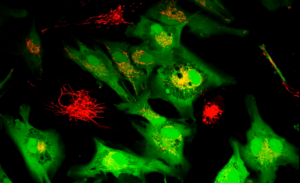
In a significant advancement for medical diagnostics, researchers at the Carl R. Woese Institute for Genomic Biology have developed innovative techniques to improve biosensors for the early detection of disease biomarkers. This breakthrough promises to revolutionize point-of-care diagnostics by making tests more accessible, affordable, and rapid, eliminating the need for traditional off-site sample analysis.
Inspired by the iridescence of peacock feathers, which change color due to light interactions with nanoscopic structures called photonic crystals, scientists have harnessed these structures for biosensing technologies. By manipulating how light is absorbed and reflected, photonic crystals can be engineered for various applications, offering a powerful tool for detecting diseases at their earliest stages.
Innovations in Photonic Crystal-Based Biosensors
The Nanosensors Group at the University of Illinois Urbana-Champaign, led by Professor Brian Cunningham, has been at the forefront of developing photonic crystal-based biosensors. These sensors utilize gold nanoparticles to amplify fluorescence, acting as tags for detecting molecular biomarkers. However, these nanoparticles have traditionally faced limitations due to their tendency to quench fluorescence signals at close range, creating a detection “dead zone.”
Seemesh Bhaskar, an IGB fellow and lead author of a recent study, explained,
“Traditionally, metal nanoparticles, especially gold, offer the potential for fluorescence enhancement, but suffer from a fundamental flaw at close range. These nanoparticles can quench—or decrease—the very fluorescence signals they aim to amplify.”
Overcoming Limitations with Cryosoret Nanoassemblies
To address these challenges, the research team introduced a new class of cryosoret nanoassemblies. These structures, composed of gold nanoparticle subunits, are formed through rapid cryogenic freezing. This innovative approach allows for the self-assembly of nanoparticles, enhancing their collective optical behavior.
By integrating cryosoret nanoassemblies with photonic crystals, the team achieved a 200-fold increase in fluorescence signal enhancement, effectively minimizing quenching. This advancement opens new possibilities for detecting low concentrations of biomarkers, a critical factor in early disease diagnosis.
Exploring Magneto-Plasmonic Nanoassemblies
Building on their success, the researchers explored the integration of magnetic tunability into the nanoassemblies. In a study published in APL Materials, Bhaskar and his colleagues designed magneto-plasmonic cryosoret nanoassemblies. These assemblies harness both the electric and magnetic components of light, a largely untapped resource in biosensing technologies.
Their platform demonstrated ultra-sensitive detection capabilities in the attomolar range, further minimizing fluorescence quenching. This dual-mode interaction allows for enhanced control over light-matter interactions at the nanoscale, offering a new method to design highly sensitive and tunable biosensing platforms.
Cunningham highlighted the significance of this work, stating,
“This work represents a hybrid optical platform where photons are not merely emitted—they are orchestrated. This convergence of photonic-plasmonic simulations, advanced nanofabrication, and chemical engineering principles has far-reaching implications, particularly in the realm of medical diagnostics.”
Future Directions and Implications
Looking ahead, the researchers plan to continue optimizing cryosoret nanoassemblies to target specific biomarkers, such as microRNAs, circulating tumor DNA, and viral particles. Their goal is to enhance early detection capabilities for cancer and infectious diseases, ultimately meeting the pressing need for sensitive, accessible, and deployable biosensing systems.
The publications detailing these findings can be accessed in MRS Bulletin and APL Materials, providing comprehensive insights into the methodologies and implications of this groundbreaking research. Supported by the National Institutes of Health, National Science Foundation, and Cancer Center at Illinois, this work represents a pivotal step forward in the field of medical diagnostics.
As the demand for rapid and precise diagnostic tools continues to grow, these advancements in nanoscale light manipulation and biosensing technology hold the potential to transform healthcare, enabling earlier interventions and improved patient outcomes.







